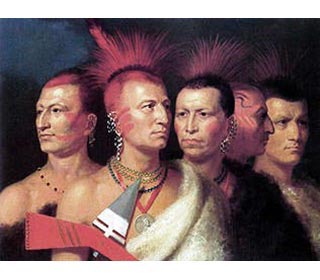History of Connecticut Indians - The French Indian Wars
The French and Indian Wars (1688 - 1763) was a generic names for a series of wars, battles and conflicts involving the French colonies in Canada and Louisiana and the 13 British colonies, which included Connecticut, consisting of King William's War (1688-1699), Queen Anne's War (1702-1713), King George's War (1744 - 1748) and the French and Indian War aka the Seven Years War (1754-1763). Various Connecticut Indian tribes were allied to the French and British colonies during the French Indian Wars which raged for nearly 75 years. Fast Facts about the History of Connecticut Indians
The climate, land, history, environment and natural resources that were available to the indigenous Indian tribes in Connecticut resulted in the adoption of the Northeast Woodlands culture. - Name of State: Connecticut
- Meaning of State name: Meaning “river whose water is driven by tides or winds.”
- Geography, Environment and Characteristics of the State of Connecticut: Narrow lowlands and hilly eastern upland.
- Culture adopted by Connecticut Indians: Northeast Woodlands Cultural Group
- Languages: Iroquoian and Algonquian
- Way of Life (Lifestyle): Hunter-gatherers, farmers, fishers, trappers
- Types of housing, homes or shelters: Chickees, Wigwams (aka Birchbark houses) and Longhouses
History Timeline of the Connecticut Indians - 10,000 BC: The first indigenous people were of the Paleo-Indian culture who lived in caves or were Nomadic Hunters
- 7000 BC: Archaic Period in which people built basic shelters and made stone weapons and stone tools
- 1000 AD: Woodland period with permanent houses and farming
- 1614: The first Europeans in Connecticut were Dutch traders
- 1633: Dutch traders purchased land from the Pequot Tribe and made a permanent settlement in Connecticut
- 1637: The Pequot War: In 1637 tensions between the colonists and the Pequot escalated into open warfare. The Pequots were defeated by the colonists, who were led by John Underhill and John Mason and the Narragansett and Mohican tribes who were their allies. The Pequot suffered savage retribution and many were sold as slaves
- 1675: 1675-1676 - King Philip's War. so named after Metacom (King Philip) of the Wampanoag tribe, who was called Philip by the English. The war was bloody and bitterly fought by the colonists against the Wampanoags, Narragansetts, Nipmucks, Pocumtucks, and Abenakis.The Narragansett tribe were nearly exterminated during this War.
- 1688: 1688 - 1763 The French and Indian Wars between France and Great Britain for lands in North America consisting of King William's War (1688-1699), Queen Anne's War (1702-1713), King George's War (1744 - 1748) and the French and Indian War aka the Seven Years War (1754-1763)
- 1754: 1754 - 1763: The French Indian War is won by Great Britain against the French so ending the series of conflicts known as the French and Indian Wars
- 1763: Treaty of Paris
- 1775: 1775 - 1783 - The American Revolution.
- 1776: July 4, 1776 - United States Declaration of Independence
- 1788: 1788 - January 9, 1788 Connecticut became a state in the United States of America
- 1812: 1812 - 1815: The War of 1812 between U.S. and Great Britain, ended in a stalemate but confirmed America's Independence
- 1830: Indian Removal Act
- 1832: Department of Indian Affairs established
- 1861: 1861 - 1865: The American Civil War.
- 1865: The surrender of Robert E. Lee on April 9 1865 signalled the end of the Confederacy
- 1887: Dawes General Allotment Act passed by Congress leads to the break up of the large Indian Reservations and the sale of Indian lands to white settlers
- 1969: All Indians declared citizens of U.S.
- 1979: American Indian Religious Freedom Act was passed
History of Connecticut Indians - Destruction and Decline
The history of the European invasion brought epidemic diseases such as tuberculosis, cholera, influenza, measles and smallpox. The Native Indians of Connecticut had not developed immunities against these diseases resulting in huge losses in population. Exploitation including the leverage of taxes, enforced labor and enslavement were part of their history, taking their toll on the Connecticut Indians. |
